Cells
0.0(0)
0.0(0)
Card Sorting
1/107
Earn XP
Description and Tags
Study Analytics
Name | Mastery | Learn | Test | Matching | Spaced |
|---|
No study sessions yet.
108 Terms
1
New cards
Structure of a eukaryotic cell
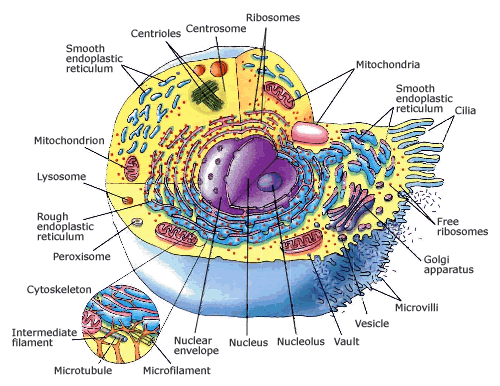
2
New cards
Structure of a prokaryotic cell

3
New cards
Structure of a virus
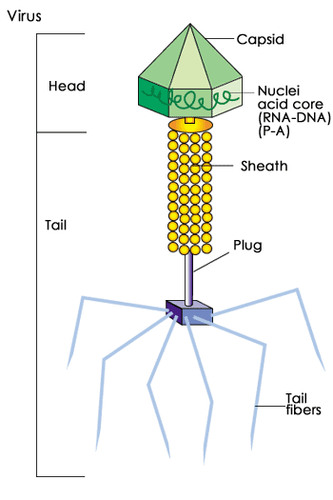
4
New cards
Cell surface membrane
- Found on inside surface of animal cells, inside cell wall of other cells
- Made mainly of lipids and proteins
- Regulates movement of substances, into and out of cell
- Has receptor molecules, so can respond to chemicals, e.g. hormones
- Made mainly of lipids and proteins
- Regulates movement of substances, into and out of cell
- Has receptor molecules, so can respond to chemicals, e.g. hormones
5
New cards
Nucleus
- A large organelle surrounded by a nuclear envelope, contains pores
- Contains chromosomes (made from protein bound linear DNA)
- Contains nucleotides
- Controls cell's activity (controls transcription of DNA)
- Nucleolus makes ribosomes
- Contains chromosomes (made from protein bound linear DNA)
- Contains nucleotides
- Controls cell's activity (controls transcription of DNA)
- Nucleolus makes ribosomes
6
New cards
Mitochondrion
- Has a double membrane
- Inner membrane is folded to form cristae, inside this is the matrix, which contains enzymes involved in respiration
- Site of aerobic respiration to produce ATP
- Inner membrane is folded to form cristae, inside this is the matrix, which contains enzymes involved in respiration
- Site of aerobic respiration to produce ATP
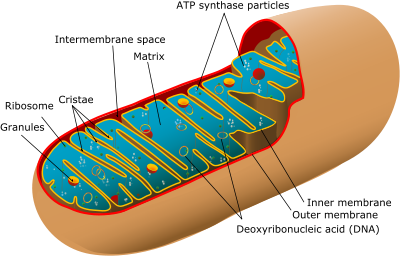
7
New cards
Chloroplast
- Small, flattened structure found in plant and algal cells
- Surrounded by a double membrane, has inner thylakoid membranes which are stacked up to form grant, grant are linked by lamellae, then, flat pieces of thylakoid membrane
- Site where photosynthesis takes place - some in grant and some in stroma (fluid)
- Surrounded by a double membrane, has inner thylakoid membranes which are stacked up to form grant, grant are linked by lamellae, then, flat pieces of thylakoid membrane
- Site where photosynthesis takes place - some in grant and some in stroma (fluid)
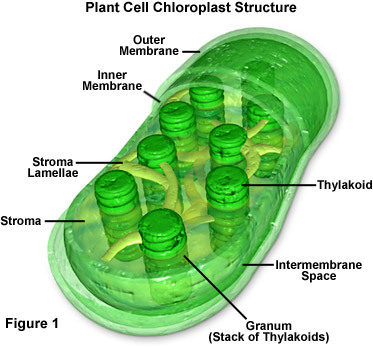
8
New cards
Golgi apparatus
- Group of fluid-filled, membrane-bound flattened sacs
- Vesicles are often seen at the edges of sacs
- Modifies, packages and transports new lipids and proteins, also makes lysosomes
- Vesicles are often seen at the edges of sacs
- Modifies, packages and transports new lipids and proteins, also makes lysosomes
9
New cards
Golgi vesicle
- Small, fluid-filled sac in cytoplasm, surrounded by membrane
- Stores lipids and proteins made by golgi apparatus, then transports out of cell
- Stores lipids and proteins made by golgi apparatus, then transports out of cell
10
New cards
Lysosome
- Round organelle surrounded by membrane
- Contains hydrolytic digestive enzymes, to digest invading cells or break down old components of the cell
- Contains hydrolytic digestive enzymes, to digest invading cells or break down old components of the cell
11
New cards
Ribosome
- Small, free floating in cytoplasm, or attached to rough ER
- Made up of proteins and RNA
- Site where proteins are synthesised
- Made up of proteins and RNA
- Site where proteins are synthesised
12
New cards
Rough endoplasmic reticulum
- System of membranes enclosing a fluid-filled space - covered with ribosomes
- Folds and processes proteins that have been made at ribosomes
- Folds and processes proteins that have been made at ribosomes
13
New cards
Smooth endoplasmic reticulum
- Similar to RER, but no ribosomes
- Synthesises and processes lipids
- Synthesises and processes lipids
14
New cards
Cell wall
- Rigid structure that surrounds cells in plants, algae, fungi
- Made of cellulose / chitin (in fungi)
- Supports cell and prevent it form changing shape
- Made of cellulose / chitin (in fungi)
- Supports cell and prevent it form changing shape
15
New cards
Cell vacuole (plant cells)
- Found in cytoplasm, contains cell sap-solution of sugar and salts
- Surrounding membrane is called tonoplast
- Helps maintain pressure inside cell and keep cell rigid
- Also involved in isolation of unwanted chemicals in the cell
- Surrounding membrane is called tonoplast
- Helps maintain pressure inside cell and keep cell rigid
- Also involved in isolation of unwanted chemicals in the cell
16
New cards
Why are epithelial cells described as specialised cells?
- In small intestine, adapted to absorb efficiently
- Villi on walls increase surface area
- Villi have folds in cell surface membrane called microvilli to increase surface area
- Lots of mitochondria, to provide energy for transport of digested food molecules into cell
- Villi on walls increase surface area
- Villi have folds in cell surface membrane called microvilli to increase surface area
- Lots of mitochondria, to provide energy for transport of digested food molecules into cell
17
New cards
Why are red blood cells described as specialised cells?
- No nucleus, so more room for O2
- Concave, increase surface area
- Concave, increase surface area
18
New cards
Why are sperm cells described as specialised cells?
- Many mitochondria, to provide energy
- Flagellum to aid movement forward
- Flagellum to aid movement forward
19
New cards
Magnification
How much bigger an image is than specimen
20
New cards
Resolution
How well microscope distinguishes between 2 points
21
New cards
What is the equation for image size?
image size = magnification x actual size
22
New cards
How many micrometres in 1 millimetre?
1000
23
New cards
How many nanometres in 1 micrometre?
1000
24
New cards
How do optical (light) microscopes work?
Use light to form an image, focused by glass lenses, air
25
New cards
Advantages of optical microscopes
- Cheap
- Easy to maintain
- View living organisms
- Easy to maintain
- View living organisms
26
New cards
Disadvantages of optical microscopes
- Low resolution
- Low magnification
- Low magnification
27
New cards
How do transmission electron microscopes work?
Use electromagnets to focus a beam of electrons, transmitted through the specimen. Denser parts absorb more electrons, so appear darker in image, in vacuum
28
New cards
Advantages of TEM
- High resolution
29
New cards
Disadvantages of TEM
- Only for thin specimen
- Only for non-living specimen
- Only for non-living specimen
30
New cards
How do scanning electron microscopes work?
Scans a beam of electrons across specimen to knock off electron from specimen, which are gathered in a cathode tube to form an image
31
New cards
Advantages of SEM
- Used on thick specimens
- 3D image
- 3D image
32
New cards
Disadvantages of SEM
- Lower resolution
- Only non-living specimens
- Only non-living specimens
33
New cards
How do you prepare an optical microscope slide?
- Put specimen on glass slide, using temporary mount
- Pipette drop of water onto mount
- Use tweezers to put thin specimen on top
- Add stain and cover slip
- Pipette drop of water onto mount
- Use tweezers to put thin specimen on top
- Add stain and cover slip
34
New cards
What are artefacts?
Things that you can see that aren't part of the specimen
35
New cards
Stages of cell fractionation
1. Homogenisation - break plasma membrane and release cells into solution
2. Filtration - separate large cell/tissue debris
3. Ultracentrifugation - Pour cell fragments into tube, centrifuge at low speed (heaviest organelles, e.g. nucleus, form a sediment pellet), supernatant drained off, poured into another tube, spun at a higher speed until all organelles separated out
2. Filtration - separate large cell/tissue debris
3. Ultracentrifugation - Pour cell fragments into tube, centrifuge at low speed (heaviest organelles, e.g. nucleus, form a sediment pellet), supernatant drained off, poured into another tube, spun at a higher speed until all organelles separated out
36
New cards
In cell fractionation, why is solution ice cold?
To reduce enzyme activity
37
New cards
In cell fractionation, why is solution isotonic?
To prevent osmotic effects
38
New cards
In cell fractionation, why is solution buffered?
To maintain pH
39
New cards
Describe interphase
G1 - cell grows, new organelles and proteins made
S - DNA unravels and replicated, ready to divide
G2 - cell grows, proteins needed for mitosis made, ATP content increased
S - DNA unravels and replicated, ready to divide
G2 - cell grows, proteins needed for mitosis made, ATP content increased
40
New cards
Describe prophase
- Chromosomes shorten and thicken (condense)
- Centrioles move to opposite points, forming spindle fibres
- Nuclear envelope breaks down, chromosomes free in cytoplasm
- Centrioles move to opposite points, forming spindle fibres
- Nuclear envelope breaks down, chromosomes free in cytoplasm
41
New cards
Describe metaphase
- Chromosomes line up on equator of cell, attach to spindle fibres by centromeres
42
New cards
Describe anaphase
- Centromeres divide, separating each pair of sister chromatids
- Spindles contract, pulling them to opposite poles
- Spindles contract, pulling them to opposite poles
43
New cards
Describe telophase
- Chromatids uncoil, become long and thin = chromosomes
- Nuclear envelope forms around each group = 2 nuclei
- Nuclear envelope forms around each group = 2 nuclei
44
New cards
Describe cytokinesis
Cytoplasm divides, creating 2 identical daughter cells
45
New cards
What is cancer?
The uncontrollable division of cells, leading to the formation of tumours and cancers
46
New cards
Chemotherapy
Prevents synthesis of enzymes needed for DNA replication, so cell is unable to live G1 stage to S, so cell cycle is interrupted and cell kills itself
47
New cards
Radiotherapy
Damages DNA, this damage is detected at check-points, and the cell kills itself
48
New cards
Hormone therapy
Stops growth of cancers dependent on hormones, e.g. prostate cancer
49
New cards
Surgery
Removes tumour
50
New cards
What are the stages of binary fission?
1. Circular DNA and plasmids replicate
2. Cell gets bigger, DNA loops move to opposite poles
3. Cytoplasm begins to divide (cell wall forms)
4. Cytoplasm divides and 2 daughter cells formed, each with 1 copy of loop of DNA, but variable plasmids
2. Cell gets bigger, DNA loops move to opposite poles
3. Cytoplasm begins to divide (cell wall forms)
4. Cytoplasm divides and 2 daughter cells formed, each with 1 copy of loop of DNA, but variable plasmids
51
New cards
What are the stages of virus replication?
1. Viruses attach to host cell's receptor proteins
2. Genetic material (nucleic acid) injected into host cell
3. Host cell replicates injected material
4. Viral components assemble (viruses formed)
5. Replicated viruses 'burst' out, causing death of host cell
2. Genetic material (nucleic acid) injected into host cell
3. Host cell replicates injected material
4. Viral components assemble (viruses formed)
5. Replicated viruses 'burst' out, causing death of host cell
52
New cards
Describe the fluid mosaic model of the cell membrane
- Phopholipid molecules form a bilayer which is fluid (molecules constantly moving)
- Heads = hydrophilic, tails = hydrophobic
- Once emerged in water, the orientate themselves to form a bilayer, meaning they are amphipathic
- Bilayer is not bonded, stable and enables molecules to move freely
- Small, non-polar molecules can pass bilayer easily, and H2O even through it is polar
Channel and carrier proteins present
- Heads = hydrophilic, tails = hydrophobic
- Once emerged in water, the orientate themselves to form a bilayer, meaning they are amphipathic
- Bilayer is not bonded, stable and enables molecules to move freely
- Small, non-polar molecules can pass bilayer easily, and H2O even through it is polar
Channel and carrier proteins present
53
New cards
What are intrinsic proteins?
Span both lengths of phospholipid bilayer
54
New cards
What are extrinsic proteins?
Span one length of phospholipid bilayer
55
New cards
What are glycolipids and glycoproteins?
Lipids and proteins with short carbohydrate chains attached to them
56
New cards
How does temperature affect the phospholipid bilayer?
- Below 0 - little energy, tightly packed, channel and carrier proteins denature
- 0 to 45 - more energy, highly permeable
- 45+ - bilayer starts to break down, more permeable, channel and carrier proteins denature
- 0 to 45 - more energy, highly permeable
- 45+ - bilayer starts to break down, more permeable, channel and carrier proteins denature
57
New cards
Describe simple diffusion
- Passive
- Net movement of particles from high to low concentration
- Steeper gradient = higher rate of diffusion
- Small, non-polar and H2O can pass easily
- Net movement of particles from high to low concentration
- Steeper gradient = higher rate of diffusion
- Small, non-polar and H2O can pass easily
58
New cards
What factors affect diffusion?
- Length of diffusion pathway
- Surface area
- Concentration gradient
- Surface area
- Concentration gradient
59
New cards
Describe facilitated diffusion
- Passive
- Large or charged particles diffuse through carrier or channel proteins
- Down concentration gradient (high to low)
- Uses carrier and channel proteins
- Large or charged particles diffuse through carrier or channel proteins
- Down concentration gradient (high to low)
- Uses carrier and channel proteins
60
New cards
Carrier proteins
Attached to molecule, protein changes shape to allow molecule to pass through membrane
61
New cards
Channel proteins
Form pores in membrane for particles to diffuse through
62
New cards
What factors affect facilitated diffusion?
- Concentration gradient
- Number of proteins
- Number of proteins
63
New cards
Describe osmosis
- Passive
- Diffusion of water molecules across a partially permeable membrane from area of high water potential to low water potential
- More negative the water potential = more solutes
- Diffusion of water molecules across a partially permeable membrane from area of high water potential to low water potential
- More negative the water potential = more solutes
64
New cards
Describe isotonic solution and its effect on animal and plant cells
- Same water potential in and out of cell
- No net movement of water
- No change, plant may be flaccid
- No net movement of water
- No change, plant may be flaccid
65
New cards
Describe hypOtonic solution and its effect on animal and plant cells
- Higher water potential outside cell
- Animal = lysis
- Plant = turgid
- Animal = lysis
- Plant = turgid
66
New cards
Describe hypERtonic solution and its effect on animal and plant cells
- Higher water potential inside cell
- Animal = crenation
- Plant = cytoplasm shrinks, plasmolysis
- Animal = crenation
- Plant = cytoplasm shrinks, plasmolysis
67
New cards
Factors affecting osmosis
- Water potential gradient
- Thickness of exchange surface
- Surface area
- Thickness of exchange surface
- Surface area
68
New cards
Describe active transport
- Active
- Against concentration gradient
- Carrier proteins - a molecule attaches, protein changes shape which moves molecule across membrane
- ATP hydrolysed to form ADP and Pi, which releases energy so solutes can be transported
- Against concentration gradient
- Carrier proteins - a molecule attaches, protein changes shape which moves molecule across membrane
- ATP hydrolysed to form ADP and Pi, which releases energy so solutes can be transported
69
New cards
Co-transport of sodium and glucose
1. Na+ ions are pumped out of epithelial cel to blood by active transport, through sodium-potassium pump
2. This creates a concentration gradient, as there is a higher conc of Na+ in lumen than cell
3. Na+ ions enter epithelial cell from lumen, through symports via co-tranport with glucose
4. Concentration of glucose inside cell increases
5. Glucose moves down conc gradient into blood by facilitated diffusion
2. This creates a concentration gradient, as there is a higher conc of Na+ in lumen than cell
3. Na+ ions enter epithelial cell from lumen, through symports via co-tranport with glucose
4. Concentration of glucose inside cell increases
5. Glucose moves down conc gradient into blood by facilitated diffusion
70
New cards
Factors affecting co-tranport
- Speed of carrier proteins
- Number of carrier proteins
- Rate of respiration and availability of ATP
- Number of carrier proteins
- Rate of respiration and availability of ATP
71
New cards
What is an antigen?
Molecules that generate an immune response
72
New cards
What is a pathogen?
Organisms that cause disease, have foreign antigens on their surface
73
New cards
What are abnormal body cells?
Cancerous or pathogen infected cells with abnormal antigens on surface
74
New cards
What is a toxin?
Poisonous molecules (no antigens)
75
New cards
Why are cells from other individuals of same species issues?
e.g. organ transplant or blood transfusion - different antigens
76
New cards
What is antigenic variation?
Pathogens change their surface antigens due to changes in DNA code
77
New cards
Describe phagocytosis
- Non-specific response
- A phagocyte recognises foreign antigens on pathogen, as the pathogen's chemical products attract phagocytes
- Phagocytes bind to pathogen's surface, as receptors bind to antibodies
- The membrane of phagocyte folds inwards, forming pseudopodia, so pathogen is trapped in phagosome
- Lysosomes fuse with phagosomes, and release hydrolytic digestive enzymes (e.g. lysozyme) which digest the bacterium
- Nutrients can then be absorbed in cytoplasm or exocytosed
- A phagocyte recognises foreign antigens on pathogen, as the pathogen's chemical products attract phagocytes
- Phagocytes bind to pathogen's surface, as receptors bind to antibodies
- The membrane of phagocyte folds inwards, forming pseudopodia, so pathogen is trapped in phagosome
- Lysosomes fuse with phagosomes, and release hydrolytic digestive enzymes (e.g. lysozyme) which digest the bacterium
- Nutrients can then be absorbed in cytoplasm or exocytosed
78
New cards
What is a phagocyte?
A phagocyte (e.g. macrophage/neutrophil) is a type of WBC found in blood and tissues and are the first cells to respond to an immune system trigger
79
New cards
Describe the response of a helper T cell in the cellular response
- Specific response
1. Antigen-presenting cell comes into contact with T cell
2. Helper T cells divide by mitosis to produce clones = clonal selection
3. Release cytokines which stimulate B cells and cytotoxic T cells and macrophages to carry out phagocytosis
1. Antigen-presenting cell comes into contact with T cell
2. Helper T cells divide by mitosis to produce clones = clonal selection
3. Release cytokines which stimulate B cells and cytotoxic T cells and macrophages to carry out phagocytosis
80
New cards
Describe the response of a cytotoxic T cell in the cellular response
- Specific response
1. Antigen-presenting cell comes into contact with T cell
2. Cytotoxic T cells divide by mitosis to produce clones = clonal selection
3. Each Tc cell will attach to specific antigens it has receptors for
4. Secretes toxic substances, such as hydrogen peroxide, which pierces holes in membrane
5. Causes death of cell
1. Antigen-presenting cell comes into contact with T cell
2. Cytotoxic T cells divide by mitosis to produce clones = clonal selection
3. Each Tc cell will attach to specific antigens it has receptors for
4. Secretes toxic substances, such as hydrogen peroxide, which pierces holes in membrane
5. Causes death of cell
81
New cards
Describe the role of B lymphocytes in the humeral response
- Specific response
1. B lymphocyte comes into contact with antigen-presenting cell
2. Activated B cell divides by mitosis = clonal selection
3. Plasma cells have large numbers of ribosomes to manufacture and secrete lots of specific antibodies which attach to antigens to destroy cell
(antibodies produced by plasma cells are monoclonal antibodies as they are genetically identical)
4. Memory cells remember antibodies so when antigens invade again, they can be destroyed before symptoms occur
1. B lymphocyte comes into contact with antigen-presenting cell
2. Activated B cell divides by mitosis = clonal selection
3. Plasma cells have large numbers of ribosomes to manufacture and secrete lots of specific antibodies which attach to antigens to destroy cell
(antibodies produced by plasma cells are monoclonal antibodies as they are genetically identical)
4. Memory cells remember antibodies so when antigens invade again, they can be destroyed before symptoms occur
82
New cards
What is an antibody?
A protein produces by lymphocytes, in response to the presence of the complementary antigen
83
New cards
Structure of an antibody
- The shape of antigen-binding site and side chains on amino acids are different for different antibodies
- Bonds form with specific antigen to form an antigen-antibody complex
- Bonds form with specific antigen to form an antigen-antibody complex
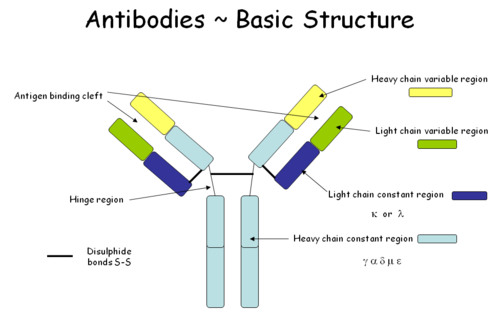
84
New cards
What is agglutination?
- When many antibodies attach to antigens on surface of bacteria
- Bacteria clumps together, stuck and unable to move or reproduce
- This attracts macrophages and neutrophils which destroy them by phagocytosis
- Bacteria clumps together, stuck and unable to move or reproduce
- This attracts macrophages and neutrophils which destroy them by phagocytosis
85
New cards
Primary and secondary immune response
- At first exposure, it takes time for plasma cells to meet pathogen and clone
- At second exposure, memory cells can produce antibodies quickly as antigen is recognised
- At second exposure, memory cells can produce antibodies quickly as antigen is recognised
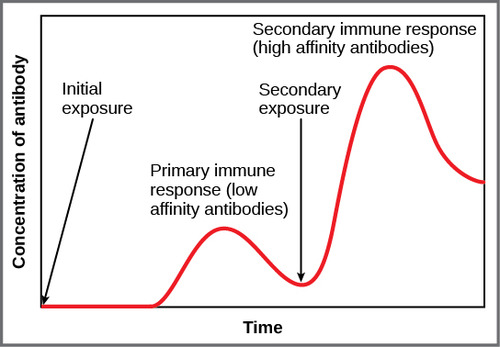
86
New cards
What is antigenic variability? Give an example
Caused by mutations, e.g. new flu strain each year as old vaccine will not work
87
New cards
Describe what happens when a vaccination is given
- Vaccine contains dead or attenuated pathogen
- Vaccine is injected which stimulates a primary response which leaves memory cells to generate a secondary response if individual is infected again
- Prevents significant harm while primary response is happening
- Vaccine is injected which stimulates a primary response which leaves memory cells to generate a secondary response if individual is infected again
- Prevents significant harm while primary response is happening
88
New cards
What is active immunity?
Person is exposed to antigen and makes their own antibodies against it, retaining memory cells for long-lasting immunity
89
New cards
What is passive immunity?
Person does not make their own antibodies so memory cells do not retain info, short-term immunity
90
New cards
What is herd immunity?
- As long as most (about 95%) are vaccinated, it usually does not matter if a few are not
- It would be very difficult for bacteria/virus to move to unvaccinated individuals
- Protects young children and people with an immune system that is not working effectively
- It would be very difficult for bacteria/virus to move to unvaccinated individuals
- Protects young children and people with an immune system that is not working effectively
91
New cards
Structure of HIV

92
New cards
What does HIV stand for?
Human Immunodeficiency Virus
93
New cards
Why is HIV described as a retrovirus?
Genetic material is RNA, not DNA
94
New cards
Describe HIV replication
- HIV infects a particular type of helper T cell
1. Membrane contains glycoproteins which enable virus to identify, bind to and fuse with host cell
2. Once it enters, RNA is converted to DNA using enzyme reverse transcriptase
3. This codes for production of new viruses
4. DNA is incorporated into chromosomes of host cell
5. Person can live for many years without symptoms
6. Eventually, viral DNA is activated, transcribed and translated and bursts out
1. Membrane contains glycoproteins which enable virus to identify, bind to and fuse with host cell
2. Once it enters, RNA is converted to DNA using enzyme reverse transcriptase
3. This codes for production of new viruses
4. DNA is incorporated into chromosomes of host cell
5. Person can live for many years without symptoms
6. Eventually, viral DNA is activated, transcribed and translated and bursts out
95
New cards
How is AIDS acquired?
1. Body produces anti-HIV antibodies
2. Gradually, number of functioning helper T cells decreases
3. Eventually, there are so few Th cells left that the person is unable to fight off other pathogens
4. AIDS is acquired
2. Gradually, number of functioning helper T cells decreases
3. Eventually, there are so few Th cells left that the person is unable to fight off other pathogens
4. AIDS is acquired
96
New cards
What does AIDS stand for?
Acquired Immunodeficiency Syndrome
97
New cards
Why are antibiotics ineffective against HIV?
Antibiotics destroy cell walls or interfere with metabolic pathways in cells, but viruses are acellular = no cell wall or metabolism
98
New cards
What are used to treat HIV and how do they work?
- Antiretrovirals (ARV) bind to revers transcriptase and stop it from copying virus' DNA
- Do not cure HIV, just prevents symptoms worsening
- Do not cure HIV, just prevents symptoms worsening
99
New cards
What are monoclonal antibodies?
Antibodies produced by large clones of plasma cells, all secrete same specific antibody
100
New cards
How are monoclonal antibodies useful in medicine?
- Can be produced with complementary shapes to abnormal proteins (e.g. cancer) and bind to cancer cells to deliver drug to those cells only
- Used in medical diagnosis (e.g. pregnancy tests - monoclonal antibody binds to HCG hormone which causes a colour change)
- Reduce effects of auto-immune diseases
- Used in medical diagnosis (e.g. pregnancy tests - monoclonal antibody binds to HCG hormone which causes a colour change)
- Reduce effects of auto-immune diseases